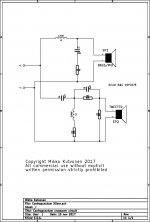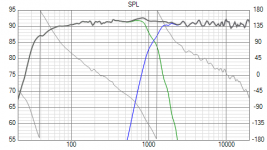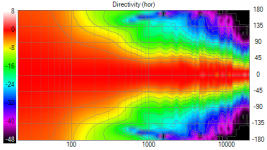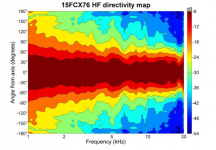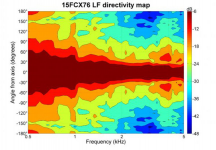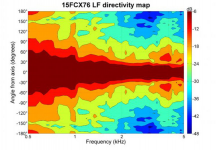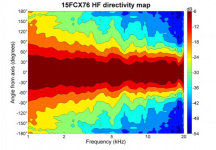That makes sense.
Yes those JBL's are a source of inspiration for me. I'm running 2x18's per side. It really is hybrid pa/hifi system.
I did try ruler flat at first but it was definitely way to bright. I took down 2k-10k by 2dB. 10-16k has a 1dB drop. Sounds the most natural on a wide variety of recordings and genres.
I worked at a very well-known recording studio in the 80's and recall that we intentionally rolled off the high end when "voicing" a control room. I believe it was 3 db per octave above 6.3 KHz, a gentle slope that cured the "harshness" of the TAD compression drivers that were in vogue at the time.
Member
Joined 2009
Paid Member
Just for reference, here is about as large as the large format coaxial systems get. 
http://www.diyaudio.com/forums/multi-way/110583-fast-fun-inexpensive-ob-project-143.html#post4702952
http://www.diyaudio.com/forums/multi-way/110583-fast-fun-inexpensive-ob-project-143.html#post4702952
Okay, I know this post might at first seem like another futile attempt at thread necromancing, but it isn't exactly that. I've been working on this project on and off since I first bought these drivers a couple of years ago, and it's been a long ride, partly due to me striving for perfection. Anyhow, I think somewhere along this long(ish) thread I made the promise to not let this particular thread end up a dead end street, so here goes nothing.
I've gone through numerous iterations of crossovers and a couple of cabinets, and finally arrived where I can say that this project - at least for me - is at last a closed book. I've been balancing between clarity, perceived resolution and "easy listening". I have no use for speakers that rob me the ability to enjoy recordings that are subpar sound quality -wise, so the end result might not sound like your usual high-end speaker. The resolution is there, it's just that it isn't underlined like so many commercial speakers do just to give you that easy wow-factor.
The last changes I made in the crossover made me think that I've finally come where I wanted this to go. I wanted a coaxial 2-way that goes down low enough not to require a subwoofer and having that magical midrange coherence only coaxials tend to offer apart from fullranges. And of course, a grain free treble range was also a part of my wishlist.
There are more expensive 15 inch coaxials on the market, but this B&C one really ticks most of the boxes. It extends to 18kHz, which is 'nuff for most people. In a suitable room it can go as low as 20Hz, but that takes stone walls. In my listening room, that leaks low frequencies almost like there were no walls at all it can still go straight down to low thirties. And I estimate a sensitivity figure around 95dB/w.
So, stay tuned for the recipe. I'll be publishing the "ingredients" in the coming days.
I've gone through numerous iterations of crossovers and a couple of cabinets, and finally arrived where I can say that this project - at least for me - is at last a closed book. I've been balancing between clarity, perceived resolution and "easy listening". I have no use for speakers that rob me the ability to enjoy recordings that are subpar sound quality -wise, so the end result might not sound like your usual high-end speaker. The resolution is there, it's just that it isn't underlined like so many commercial speakers do just to give you that easy wow-factor.
The last changes I made in the crossover made me think that I've finally come where I wanted this to go. I wanted a coaxial 2-way that goes down low enough not to require a subwoofer and having that magical midrange coherence only coaxials tend to offer apart from fullranges. And of course, a grain free treble range was also a part of my wishlist.
There are more expensive 15 inch coaxials on the market, but this B&C one really ticks most of the boxes. It extends to 18kHz, which is 'nuff for most people. In a suitable room it can go as low as 20Hz, but that takes stone walls. In my listening room, that leaks low frequencies almost like there were no walls at all it can still go straight down to low thirties. And I estimate a sensitivity figure around 95dB/w.
So, stay tuned for the recipe. I'll be publishing the "ingredients" in the coming days.
I've gone through numerous iterations of crossovers and a couple of cabinets, and finally arrived where I can say that this project - at least for me - is at last a closed book..
Congratulations!
I will be interested in seeing the "ingredients"
.
So, stay tuned for the recipe. I'll be publishing the "ingredients" in the coming days.
^I accidentally kinda got carried away on a completely different tangent (guitar amps), so please have some patience. It's just that "coming days" can sometimes be a question of relativity.
It's coming, alright..? I'll just have to reorient my mind back to this project...
It's coming, alright..? I'll just have to reorient my mind back to this project...
Okay. It seems that projects just keep piling at my desk without request. Just as I was thinking my way around a simple and small power guitar amp, a certain person threw a pair of Quad ESL-2805's at me, that were in need of some tender lovin' and carin'...
But since I try to stay committed to this project, I'll start by publishing the crossover. And that'll happen in some time, I'll just need to grab another beer...
But since I try to stay committed to this project, I'll start by publishing the crossover. And that'll happen in some time, I'll just need to grab another beer...
A 15-inch two-way coaxial speaker - the ingredients and the crossover
Okay. So, back when I started this thread, my goal was a two-way speaker that could hit the mark of producing the lowest notes of a bass guitar with aplomb. And I'm quite happy to report that this mark was met, and even exceeded, though slightly depending on your room.
And of course I wanted this goal to be met with a coaxial driver. Not an easy task, mind you. With these goals and driver sizes we've nothing to utilize but PA-drivers, and most of these are unusable for Hi-Fi use. Most, but not all of them, mind you.
I think it was "ScottG" here at diyaudio.com, who pointed me to take a look at B&C's quite recent 15FCX76 drivers. And this was luckily no dead end. They do however need some space to thrive, when it comes to the enclosure. A hundred liters isn't enough, but 170-180 liters is nearer the optimum. Now, these speakers do rely on some room enforcement in the lowest octaves, but that seems to be normal with most high efficiency designs. What you end up with is something like 95dB/W/m efficiency and a response that goes straight down to 20-40Hz depending on your room. Not that bad for a two-way design? It took me quite a while to finalize the crossover, though. These large PA-coaxials are just that much harder to work with. Not because of their response, but more because of their directivity. They're not pointy, as some panels are, but they nonetheless have a very different directivity pattern to most "normal" loudspeakers (read: 6,5" 'bass' and a dome tweet...). This means you have to voice them very differently. A completely straight response isn't what you're aiming for, lest you want to feel the listening fatigue...
So, thus far we have the first two prime ingredients, the driver and the crossover. The crossover is in the file attached, though feel free to ask me for more info if you feel like it.
Though the crossover seems to be electrically of the second order, it's actually closer to third order acoustically. Considering components, use the best quality polypropylene caps you can afford. The first coil on the bass hand of the X-O should be one with a low resistance. The coil on the tweet side can be an air cored one with higher resistance, doesn't matter that much here. Considering resistors, I've tried some more 'high end' ones, and for me they've been no revelation. They should nonetheless be of 10 watt variants, and use the best quality you can afford. The quality of the resistors - at least for me - makes not much of a difference. I use Jantzen wirewounds here, since they're not ridiculously expensive.
I'll try to post the specifics of the cabinetry as soon as I can. As stated, I'm currently piled up with fun (=projects), so this may take some time.
Okay. So, back when I started this thread, my goal was a two-way speaker that could hit the mark of producing the lowest notes of a bass guitar with aplomb. And I'm quite happy to report that this mark was met, and even exceeded, though slightly depending on your room.
And of course I wanted this goal to be met with a coaxial driver. Not an easy task, mind you. With these goals and driver sizes we've nothing to utilize but PA-drivers, and most of these are unusable for Hi-Fi use. Most, but not all of them, mind you.
I think it was "ScottG" here at diyaudio.com, who pointed me to take a look at B&C's quite recent 15FCX76 drivers. And this was luckily no dead end. They do however need some space to thrive, when it comes to the enclosure. A hundred liters isn't enough, but 170-180 liters is nearer the optimum. Now, these speakers do rely on some room enforcement in the lowest octaves, but that seems to be normal with most high efficiency designs. What you end up with is something like 95dB/W/m efficiency and a response that goes straight down to 20-40Hz depending on your room. Not that bad for a two-way design? It took me quite a while to finalize the crossover, though. These large PA-coaxials are just that much harder to work with. Not because of their response, but more because of their directivity. They're not pointy, as some panels are, but they nonetheless have a very different directivity pattern to most "normal" loudspeakers (read: 6,5" 'bass' and a dome tweet...). This means you have to voice them very differently. A completely straight response isn't what you're aiming for, lest you want to feel the listening fatigue...
So, thus far we have the first two prime ingredients, the driver and the crossover. The crossover is in the file attached, though feel free to ask me for more info if you feel like it.
Though the crossover seems to be electrically of the second order, it's actually closer to third order acoustically. Considering components, use the best quality polypropylene caps you can afford. The first coil on the bass hand of the X-O should be one with a low resistance. The coil on the tweet side can be an air cored one with higher resistance, doesn't matter that much here. Considering resistors, I've tried some more 'high end' ones, and for me they've been no revelation. They should nonetheless be of 10 watt variants, and use the best quality you can afford. The quality of the resistors - at least for me - makes not much of a difference. I use Jantzen wirewounds here, since they're not ridiculously expensive.
I'll try to post the specifics of the cabinetry as soon as I can. As stated, I'm currently piled up with fun (=projects), so this may take some time.
Attachments
The thing I find tough about Coaxial drivers is - where to set the crossover point?
The woofer cone rarely seems to make a horn quite big enough for the tweeter to cross at a point low enough to be inside the good response of the woofer cone. The smaller the cone, the higher you can cross it, but then the smaller the resulting horn! The two chase each other.
I suppose with DSP and very steep slopes it could be done neatly.
I've had some luck with passive crossovers on 18" and 15" coax. Not so good on smaller.
I thought this would be interesting addition:
Taipuu Speakers
Taipuu Speakers DSP active speakers - Taipuu Speakers
-maybe?:
B&C Speakers
or (the coaxial used in this thread),
B&C Speakers
(..too "hot" for my liking, but very pretty measured result non-the-less.)
Last edited:
I thought this would be interesting addition:
Taipuu Speakers
Taipuu Speakers DSP active speakers - Taipuu Speakers
-maybe?:
B&C Speakers
or (the coaxial used in this thread),
B&C Speakers
It is BMS 15C262.
I'll try to post the specifics of the cabinetry as soon as I can. As stated, I'm currently piled up with fun (=projects), so this may take some time.
Interesting concept, any updates?
- Home
- Loudspeakers
- Multi-Way
- The umpteenth large format coaxial driver thread
